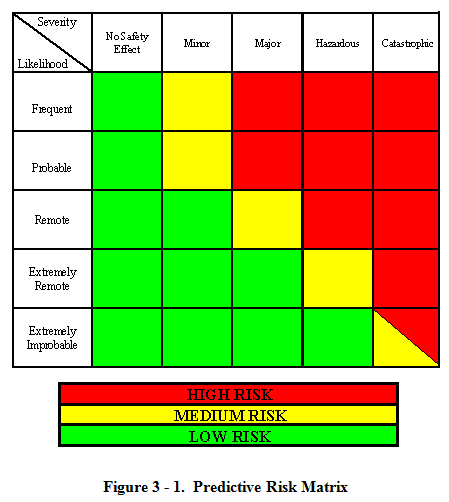Pros and Cons of Prescriptive vs Performance Based SMS

Performance vs prescriptive based approaches to aviation safety management systems (SMS) is and will increasingly be a hot topic in the aviation industry for years to come.
As it should be.
Because let’s face it, “compliant safety" is not a one-size-fits-all approach. Yet, prescriptive safety remains an endemic problem in the aviation industry.
Many of you reading this probably know what I’m talking about whenever you feel an SMS inspector is evaluating your organization either unjustly or too harshly in an SMS audit.
Related Aviation SMS Audit Articles
- Real Difference Between an Aviation Safety Audit vs. Inspection
- How to Conduct Internal SMS Audits in Aviation Industry
- Aviation Safety Audits 101: Prep and Pass – With Examples and Checklists
What Is Prescriptive Based Safety in Aviation SMS?
A prescriptive approach to SMS implementation is the strict "compliance approach" to satisfying SMS requirements, regardless of whether these SMS requirements are coming from:
- Civil aviation authorities; or
- Standards bodies, such as IATA, IS-BAO, Flight Safety Foundation.
For readers that use English as the second language, the term "prescriptive approach" can be seen in the same light as a "doctor's prescription," where the doctor is telling you to follow his prescription to cure your ailment. In the case of aviation SMS, the prescriptive approach uses highly detailed regulatory guidelines to "prescribe" what you must demonstrate to meet the minimum SMS requirements.
Operators use provided guidance material as their template for SMS implementation. Operators following the "regulators' prescription" don't try to come up with creative approaches to improving safety. If anything, these aviation service providers are looking for creative strategies to do the least possible work with the least amount of resources possible to comply with the "SMS prescription."
Challenges With Prescriptive Based SMS Implementations

As we see, compliant safety is simply an approach to safety by meeting regulatory requirements. Is this really an approach to "safety" or simply an approach to staying in business? We should not be too hasty to judge operators using the prescriptive approach. From a regulatory standpoint, we are "herding our operators" to a point where they have all elements of an SMS in place, ready to spring into action when called.
From our regulatory point of view, if we have operators possessing all functional SMS elements outlined in our prescription, our next step is to get these "barely compliant" operators to change their safety cultures and actually "practice SMS' safety concepts" as they have always been intended.
From an operator's perspective it’s easier to implement an SMS using the prescriptive approach as these implementations tend to face less resistance from management who prefer to:
- only change what is absolutely necessary for their existing risk management processes;
- only spend money and human resources on bare minimum regulatory requirements;
- use a "requirements' template" versus thinking outside the box and implementing unacceptable SMS processes.
The prescriptive approach is a natural symptom of new SMS implementations.
During the earliest years of SMS implementation, managers are simply trying to learn:
- what is SMS?
- how will it change our business?
- what resources do we need to devote for SMS compliance?
- how do we manage SMS data to demonstrate SMS compliance?
We commonly see this prescriptive approach used across the world by aviation service providers merely interested in "checking the box." They really don't care about safety, only as much as it allows employees to perform the mission and contribute to income-generating production activities.
The downside of a prescriptive approach is, mainly, the inability to adapt and adequately react to unusual incidents – both of which are serious safety concerns and indicate very strongly that a prescriptive approach is an extremely dangerous long-term strategy. Operators that adopt the prescriptive-based implementation may have all the required documented risk management processes, but it is highly unlikely that safety managers and department heads actually follow their procedures.
Smaller organizations do not have the volume of safety reports for auditors to analyze. Furthermore, auditors do not dive deep into their SMS audits. After all, an SMS's complexity is commensurate to the size and complexity of the operator. Consequently, auditors may not be as zealous in their scrutiny with a smaller operator as they are with a medium to a large operator.
Related Aviation SMS Implementation Articles
- Why Should We Implement Aviation SMS?
- SMS First Steps - How to Create an SMS Implementation Plan
- FAA Part 5 - Understanding Scope of Aviation SMS Implementation
What Is Performance-Based Safety in Aviation SMS?
Performance-based safety hinges more on the specific goals and desires of the particular organization. Unlike prescriptive-based safety, performance-based SMS implementations ideally result in well-rounded, more mature, performant aviation SMS that is ready to take their safety to the next level. Management understands the logic behind the safety risk management (SRM) and safety assurance (SA) risk management processes.
A common outcome from performance-based SMS implementations is the adoption of SMS concepts, philosophies, and risk management workflows across other areas of operation, and not simply "safety-focused." For example, the SRM-SA risk management processes are equally effective with other organizational issues, such as:
- Environmental;
- Security;
- HR; and
- Customer care.
Unfortunately, a performance approach to safety requires significantly more effort, documentation, analysis, and thoughtfulness – all of which often translates to more resources.
Moreover, performance-based safety requires a level of customized innovation that can actually open an organization up to more hazards, and potential audit findings, if implemented inappropriately.
Since performance-based safety is focused on "organizational performance," there is an increased level of sophistication surrounding data collection and performance monitoring processes. Operators that adopt performance-based safety focus on measuring SMS-related activities and using the collected data for fact-based decision-making processes.
Related Aviation SMS Performance Monitoring Articles
- 4 Pillars | How to Conduct Safety Performance Monitoring and Measurement
- How to Set and Monitor Key Performance Indicators (KPIs) in Existing SMS
- How to Be Compliant With ICAO Safety Performance Monitoring and Measurement
Indications of Prescriptive SMS

Prescriptive SMS approaches are not hard to spot. The overall theme is basing an SMS around what the regulatory agency says to do – no questions asked.
Such an organization has:
- Audits (which are already stressful) that are immensely stressful as the organization bends over backward to meet regulatory requirements, regardless of what an inspector may offer as justification;
- Very clear goals about how to comply (or how they hope to comply depending on which inspector/auditor visits them);
- Heavy focus on the performance data (i.e. numeric data) of the SMS as a whole (as opposed to individuals);
- Little tailoring of requirements for the specific program – i.e. no “interpretation” of compliance;
- Dogmatically hierarchical in structure; and
- Inflexible when it comes to “the rules.”
To some degree, all organizations should see certain tendencies of some of the above points in their SMS implementation, as it’s only natural. The difference between “tendencies” and “approach” boils down to the number and intensity that an organization can identify within the above points, as well as similar ideas in the same vein.
Indications of Performance SMS
When we are talking about performance-prescriptive, we are really talking about a spectrum that can go from one extreme to the other. Thus, performance SMS addresses similar key points as prescriptive SMS implementations, but in a different way.
They have:
- Desired performance outcomes that may differ/exceed regulatory requirements;
- Tailored monitoring of activities that are of higher organizational concern or need that align with their key performance indicators (KPIs) or safety performance indicators (SPIs);
- The habit of continually re-evaluating how to tailor their organization’s specific needs to comply with certain regulations (as opposed to pushing their regulations over their organization in a way that supersedes the SMS' needs);
- Better flexibility in adapting to new technologies and requirements (i.e. faster implementation);
- Thorough understanding of individual's role in the SMS, and how relationships between those individuals affect outcomes; and
- High levels of interaction between employees/management and the SMS.
In so many words, what I keep skating around is the fact that performance-based systems can and do bump heads with regulatory agencies for the simple fact that performance-based systems tend to be progressive and over-achieving relating to their safety initiatives. Auditors frequently become confused and necessarily cautious when operators develop risk management processes that exceed the SMS's minimum requirements.
Actively disagreeing with regulation because it does not suit well with your organization is a good sign that management is more interested in performance-based safety. The best-case scenario for any performance-based SMS is finding creative ways to meet requirements, that first and foremost address the needs of the organization. Yet there is a limit!
Safety teams need to choose their battles wisely when "negotiating" with SMS auditors and inspectors. Auditors may have personal pet peeves. Other auditors have been trained to follow a particular process to identify satisfactory compliance, and these auditors must leave their comfort zones and actually "think outside the box." As you know, the process of "thinking" requires energy. As humans, we don't like needlessly wasting energy.
Furthermore, if an auditor accepts an "unusual way of compliance," the auditor will have to justify and explain the logic for deviating from standard acceptance criteria. When asking an auditor to think outside the box, you are actually asking him for a favor. You can do it the hard way (adversarial), or the easy way (with honey).
Naturally, adopting creative SMS strategies that exceed minimum regulatory guidelines involves having an intimate understanding of just what such needs are – both from organizational and regulatory perspectives. These activities are more realistic and feasible in developed, mature aviation SMS. Newer programs will consequently, and perhaps necessarily, maintain a more prescriptive approach as they establish what their unique needs are.
Related Aviation SMS Audit Articles
- How to Think Like an Aviation SMS Auditor
- 3 Traits Good Aviation Safety Auditors Share
- Audit Checklist: 10 Things to Prepare for Aviation SMS Audits
Why Prolonged Prescriptive SMS Will Kill Your SMS

There is a time and place for prescriptive environments, as said. But prescriptive environments that persist well into the “maturity” of an SMS implementation
- stink of bureaucracy; or
- demonstrate management's focus on production over safety; or
- demonstrate an unimaginative safety culture that only wants to "check the box."
Yet, we can all agree that prescriptive SMS is the safest for management. With compliance, they can easily wave their hands-free of responsibility and claim “We met the requirements!” should an incident take place. Too bad for the people whom such incidents affect in real life.
Prescriptive environments: safe for management, not safe for anyone else.
Companies that adopt prescriptive SMS as a long-term solution have a sole focus bent on meeting the “legal” requirements and definitions of Compliance without regard to the actual effectiveness of the SMS. Moreover prescriptive standards:
- Rely on a condensation of past experience to predict future events
- Lack any *detailed* safety management strategy
- Are slow to respond to just about anything new (i.e. technology, regulation)
Okay, that all might be on the harsher side, but the basic idea is irrefutable. Some level of prescription is required and beneficial: aviation SMS needs to have faith that certain requirements ARE in the common interests of safety and that regulatory agencies have a vested interest in having the same accountabilities across the aviation industry. Moreover, for organizations implementing a new SMS, the prescriptive SMS approach is a necessary byproduct.
But the basic fact is that prescriptive approaches will always and forever remain inflexible. As technology and SMS become exponentially complex, the inability of prescriptive SMS implementations to adapt will very quickly lead to unscalable problems.
Related Aviation SMS Implementation Articles
- Is Your Aviation SMS Implementation a Farce? - With Self-Assessments
- How to Evaluate Risk Controls and Risk to Aviation SMS Implementations
- How to Implement SRM Process in Aviation SMS [With Free Checklist]
Final Thought: Performance Approach Needs Support
Aviation SMS that uses a performance-based approach inevitably has a management group that is supportive and concerned with their SMS. Without such support, then the drive to do more than what is strictly necessary will always be viewed as a resource burden and a waste of time.
Another way of putting it is that performance-based approaches are difficult when safety managers face resistance to SMS implementation from within their organization.
It’s no coincidence that aviation safety managers struggle both with resistance to the SMS as well as lifting their SMS implementations beyond merely being prescriptive. Performance-based SMS requires time and commitment, as well as doing more than what is asked.
A smart manager may be asking, how do we set ourselves apart from the competition as we practice performance-based SMS? or How can we use the advantages of performance SMS to increase our production capabilities?
Food for thought.
Performance-based SMS requires modern SMS data management strategies. You will be collecting and measuring data, lots of data. In order to monitor SMS performance, you will need tools to
- collect safety reports,
- manage audit findings,
- track safety training, and
- categorize safety data for trend analysis.
Spreadsheets are not the proper technology to effectively monitor SMS performance. You will need an SMS database.
If you don't have an SMS database or the database you are currently using to manage the SMS is substandard, then please check out these short demo videos.
Live SMS Pro Demo
Have questions? Ready to start using SMS Pro? Want to see a live demo?
Last updated in December 2025.








